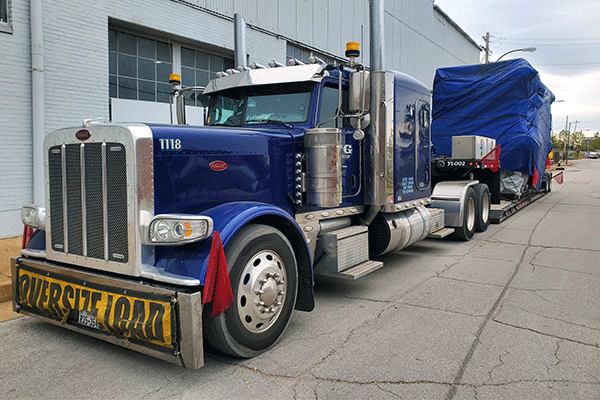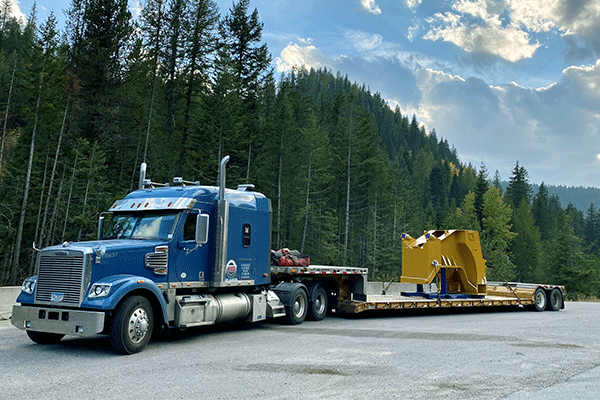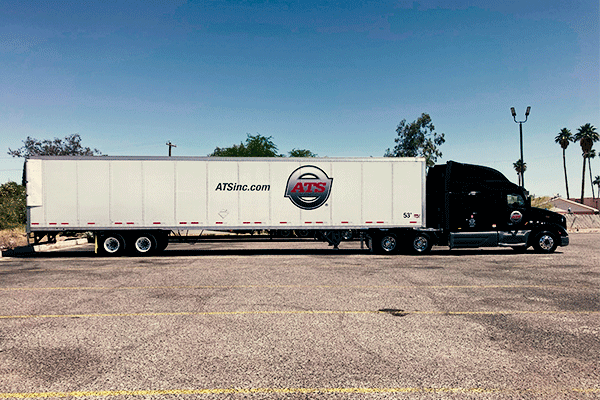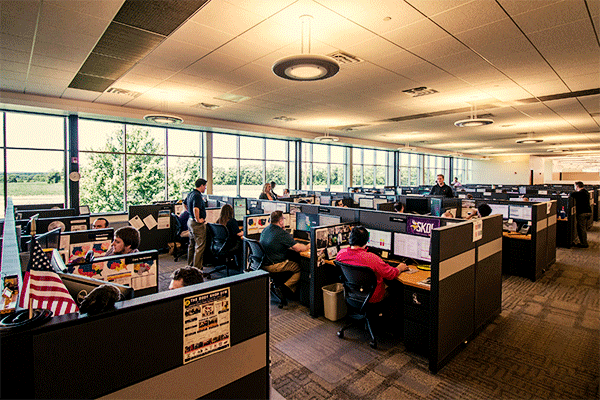
You’re good at your job and the work you do is meaningful. You care about your customers; about their goals, their success and their satisfaction. When they thrive, so does your business.
That said, you recognize that you’re only as good as your partnerships allow you to be. And, in the spirit of becoming the best in your industry, you strive to work with companies that are the best in theirs.
Too often, logistics professionals just like you — who have objectives just like yours — see their growth stunted due to shoddy transportation partnerships. Instead of consistently holding to the commitments they make and meeting the deadlines they set, companies with an unreliable mix of providers consistently fall short.
But this won’t happen to you. Today, you have a network of transportation experts — both freight brokerages and trucking companies — you trust. And you’re set on keeping it that way.
But how will you know if they fall short? Having the tools needed to evaluate the performance of your network is important. Too often, though, shippers simply don’t know what to look for or what to test their current providers against.
Here at ATS, we’ve spent nearly seven decades helping businesses around the United States move their commodities. As such, we understand how important this process is and the metrics you should use to measure your network’s performance.
In this article, we’ll tell you about the transportation industry key performance indicators you need to know, what they mean and how you can use them to ensure your network is of the highest quality.
The most important key performance indicators you should utilize in your carrier evaluation process are:
- On-time performance metrics
- Tender acceptance and rejection rates
- Invoice accuracy history
- Up-front pricing accuracy
- Intangible indicators of service quality
Let’s talk a bit about each of them.
⬇️ Check Out the Podcast Episode On This Topic ⤵️
Play Beyond The Road On Your Favorite Podcast App >
#1 On-Time Performance Metrics
On-time performance is a huge piece of your business’s long-term success. Without coming through on your word, and sticking to your timelines, your reputation will suffer.
In some aspects of your job, it’s easy to push things back. To overload your back burner with things that can be saved for a different time. The transportation of your customer’s freight is not one of them.
That said, if your on-time performance goals aren’t shared between your business and the transportation companies you use, they won’t be achievable. Sure, certain things unavoidably impact a carrier’s ability to show up on time — like bad weather and truck breakdowns. This should never become a pattern though.
In the transportation industry we use two core metrics to measure a transportation company’s overall “on-time performance” these are:
- On-time arrival rates
- On-time delivery rates
1. On-Time Arrival Rates
How often are your provider’s trucks showing up to your facility on time? How frequently are your crews left standing around waiting for a trucker to show up? Are there times when a truck simply didn’t show up, leaving you searching for a last-minute solution?
A carrier’s on-time arrival rate is the measure of these things. More specifically, this is the ratio between the number of times a truck showed up when you were told it would and the instances where it was late.
The amount of time you budget to get a truck loaded and out the door toward your consignee is important. Doing so efficiently get’s far more difficult when your truck shows up late. Make note of each time this happens and should your provider’s on-time arrival rate dip below 95% it might be time for an uncomfortable conversation.

2. On-Time Delivery Rates
The second factor you should look at when monitoring each provider’s on-time performance is their on-time delivery rates. In reality, this metric is closely tied to their arrival history. If a truck shows up late, it becomes even harder to get them out your door and to the consignee on time.
Though it varies depending on your commodity and timelines, many businesses budget two hours from the time a truck rolls onto their property to the time they leave. This window usually provides ample time for loading and securement and helps these businesses avoid potential detention fees.
That said, on-time departure — and, in turn, delivery — can falter when working with an inconsistent provider. For example, a budgeted loading/securement timeframe of 2 p.m. to 4 p.m. — that has been agreed to by your partner — will need to be adjusted if your truck is late.
And impact their ability to meet delivery deadlines. The ratio of the times a truck shows up at your consignee’s door on time and the instances it’s late is a company’s on-time delivery rate.
A transportation company’s ability to get your freight where it needs to go when it needs to get there is important. That said, there are plenty of businesses that struggle to do so consistently.
Should this become a pattern, your relationships with your customers could become strained, removing you from contending for future business and damaging your reputation.
You’ll want to avoid this. And once your provider’s on-time delivery rate starts to drop below 95% it’s time to figure out how you can better optimize together.

#2 Tender Acceptance and Rejection Rates
As an experienced shipper, you understand how important it is to have a laundry list of providers within your transportation management system (TMS). Utilizing more than one company — of more than one type — helps you ensure your pricing and service levels accurately depict market trends.
That said, sometimes tendering your freight to the companies in your network doesn’t go as planned. Although you may have selected them to move your freight and they’ve indicated their interest — either through a long-term contract or by quoting your freight on the spot — it still might not work out.
Whether it’s due to inaccurate pricing details on the front end, improper planning after quoting your freight or a myriad of other reasons, sometimes tendered freight is rejected.
If this happens now and then, there’s no need to panic.
For more regular occurrences though, when it becomes difficult to know whether a company will follow through on each load they’re tendered, concern should creep in.
In many cases, a load that’s tender is originally rejected by the primary carrier selected to move it will see a pretty significant price hike.
According to a study done by Yoo Joon Kim, a graduate student in the Supply Chain Management Program at the Massachusetts Institute of Technology (MIT), tender rejection might be hurting your business more than you’d think.
Following a five year study, wherein Kim observed the logistical management of 17 different companies — each segmented by lane and region — his findings were as follows:
- The average tender rejection rate among these 17 shippers was 19.8 percent.
- Following a rejected tender, the final price of moving the rejected load increased an average of 14.8 percent.
- Because of repeated rejections, the total transportation spending of the shippers studied increased by an average of 2.8 percent over these five years.
Read the full truckload pricing and rejection study here.
To avoid the damage of repeat tender rejections on your budget, you need partnerships that will follow through on their commitments. You tendered over your freight with the understanding that it would be covered. Repeat tender rejections are a good sign that a company simply doesn’t fit your business’s needs.
As such, tracking the tender acceptance and rejection rates of your providers will greatly improve the quality of the partnerships you hold.
For your reference, a good tender acceptance rate is 85-95%.
For some tips on improving your tender acceptance rates, and avoiding the mishaps that a rejected tender can cause, check out our blog on How Can You Increase Your Tender Acceptance Rate?
#3 Invoice Accuracy History

Your transportation invoices aren’t just useful for record-keeping and end-of-the-quarter accounting purposes. These documents also give you a window into the operational efficiency and organizational-management skills of each provider.
If you’re interested in a glance behind the curtain into how well-run your transportation provider is, analyze how accurate and comprehensive their invoices are.
- Does their invoice amount match what your records said you paid?
- Do all shipment quantity counts accurately match your bill of lading and documentation?
- Are all accessorials and additional fees outlined appropriately?
- Does the date of purchase, name and address of pick-up and delivery locations match your records?
For trucking companies and freight brokerages, customer needs should always come first. Good providers understand the lost productivity and damage that incorrect invoices can create on their customer’s end and work to prevent them.
Should a company’s invoices consistently dispute your records, this should be an indicator of one, or more, of the following things:
- This transportation provider doesn’t have the infrastructure and processes in place to provide accurate and timely invoices to the customers they serve.
- This transportation provider cut corners when setting up your account for one reason or another.
- This transportation provider is unethical and trying to turn more of a profit at your expense
- This transportation provider doesn’t care enough to service your account the way it deserves.
Sure a few inaccurate receipts are bound to pop up here or there. But, you’ll want to monitor this before it becomes a pattern. Calculate your provider’s invoice accuracy rate by dividing the correct invoices by the total amount they’ve sent you and if you’re left with a number below 95 percent it might be time to talk about it.
#4 Up-Front Pricing Accuracy
Mo money, mo problems. . .right? Actually, when it comes to budgeting for your transportation expenses, this rings true. With such price elasticity in the transportation industry, sometimes the rates you’re given on the front end don’t hold up when it matters.
Usually, it costs more to move your freight than initially quoted when one of three things has happened:
- Your transportation provider initially under-priced your load to win your business (for spot quotes).
- A lapse in communication left pertinent details from reaching your provider’s camp — making it difficult to appropriately price your freight.
- From the moment your provider quotes your load to the time it picks up, something changed. Maybe a timeline shifted, a storm popped up or a truck broke down.
The first two of these should be solvable in time. Given a bit of familiarity with your processes, freight and business, a good transportation company will be able to properly price your load each time.
That said, should invoice inaccuracy linger as time goes by, this is a good indicator that it’s time to take your business elsewhere. Be sure and take note of each time the price you’re initially given for a load isn’t the price you end up paying.
You deserve to receive a rate you can rely on. Good transportation companies understand how important this is for proper budgeting and planning on your end. And, many of them are willing to stand by their original prices even if it means they end up taking a hit.
#5 Intangible Key Performance Indicators
Although the first three KPIs on this list can be measured quite easily, there are a few KPIs that can’t be compiled into a clean-cut ratio or percentage. This doesn’t make them any less important though.
The three intangible key performance indicators that you’ll want to keep track of when evaluating your network are:
- Ease of Communication
- Level of Expertise
- Willingness to Adjust and Meet Your Needs
Let’s talk a bit about what each of these means and what you should look for when measuring each provider’s intangibles.

1. Ease of Communication
Communication is an immovable constant in the transportation industry. There’s simply no getting around it. Without facilitating transparent communication between your business and the businesses you work with, timelines will suffer.
As such, make sure to keep track of how frequently and transparently your transportation provider conveys important information.
- Do you need to continually hunt them down for updates?
- Is it possible to track your freight when it’s in their care?
- Do you have a single point of contact that reaches out and discusses any mishaps as soon as they occur?
- How valuable do they make you feel? Do they make it seem like your business is their top priority?
If your answer to any of these questions is “no,” reconsider your partnerships. Look for a company that will communicate with you the way you deserve, anything less is a disservice.
2. Level of Expertise
The second intangible KPI to measure each of your providers by is their level of expertise. You’re an expert when it comes to your product or service, you should expect that your partner is the same.
To say the transportation industry is complex would be an understatement. From trailer-interchange agreements to cross-border shipping, zone-skipping and everything in between, it takes dedication to intimately understand these intricacies.
That said, there are plenty of companies that do.
During your time as their customer, your transportation provider’s expertise should be evident.
They should right the ship when things go wrong, suggest alternative more cost-effective ways of moving your load and — based on their knowledge — always point you in the direction of your best interest.
If it’s been a while, and the current companies you’re working with aren’t doing these things, it might be time for a change. You’ll find that there are plenty of transportation providers that will openly share their expertise.
3. Willingness to Adjust and Meet Your Needs
All businesses are unique. Each corporation boasts a different history, set of employees and catalog of goals and achievements. Good transportation companies know this and do everything in their power to adjust to match each customer’s needs.
Yours should do the same for you. If you want to hold a quarterly meeting to discuss strategy and current market trends, your partner should be fully on board. Should you feel concerned about managing an upcoming peak season, your provider should offer suggestions for pre-booking loads. They can ease this burden by coordinating with consignees and ensuring everyone is on the same page.
No matter what your needs are or how unique they feel, your provider should cater their services to you. Not the other way around.
How Many Transportation Providers Should You Have?
Now that you have a better understanding of what to measure for after you’ve selected a transportation provider and some tools to help you in the future, let’s dig a bit deeper.
Getting the most from your network can often come down to having a solid network. Utilizing a good mix of provider types will help you accurately measure these KPIs for each of them.
But how many transportation providers should you have?
Too few won’t allow you to get an accurate reading on the performance of your network while too many will make it difficult to manage.
Although the answer to this question varies based on several factors, this doesn’t mean we can’t help you find out.
Check out our article on How Many Transportation Providers Should You Have? (and how to choose) for an in-depth guide on how to build your network.
At the end of the day, we want you to feel comfortable with your transportation network. As such, please don’t hesitate to reach out to us here at ATS with any questions you may have in the future.

